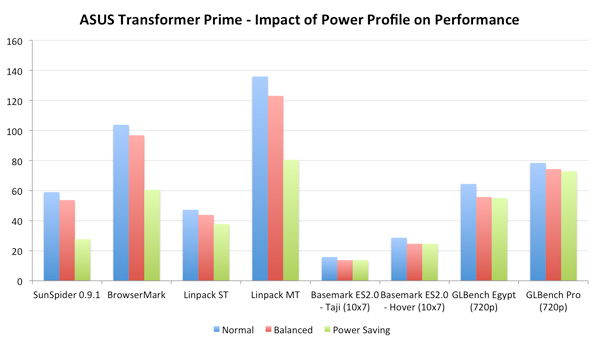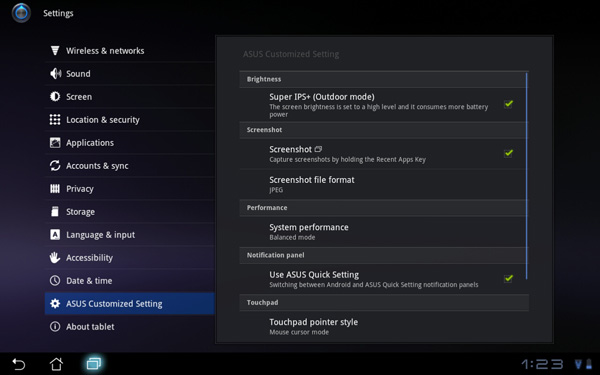ASUS Eee Pad Transformer Prime & NVIDIA Tegra 3 Review
by Anand Lal Shimpi on December 1, 2011 1:00 AM ESTThe Three Power Profiles
There are three power profiles ASUS and NVIDIA have defined on the Prime: Normal, Balanced and Power Saver. Normal allows the CPU to run at up to 1.4GHz with only a single core active, and 1.3GHz otherwise. Balanced is the default setting and it drops maximum CPU clock to 1.2GHz and favors lower clock/voltage targets on the curve compared to Normal mode. Power Saver caps CPU frequency at 1GHz with 1 - 2 cores active, 760MHz with 3 cores active and 620MHz with 4 cores active. It's unclear what the impact is on GPU clocks/performance.
Regardless of power profile, video playback capabilities are untouched - all profiles are able to play 1080p High Profile H.264 content at up to 40Mbps.
The performance impact of these various profiles varies depending on what you're doing. I ran a mixture of CPU and GPU bound tests in all profiles to measure their impact. The results are below:
I reformatted the SunSpider and BrowserMark scores to keep the magnitude of the numbers in line with the rest in the chart, and to make higher numbers = better performance across the board. For the most part you can see that the difference between Normal and Balanced is pretty small. Numerically it works out to be a 5 - 15% gap depending on the benchmark. The latter end of the range is big enough where the performance conscious will want to stay in Normal mode, but it's possible to do without it.
It's interesting to note that the impact on GPU performance isn't that major across the board. It looks like NVIDIA is primarily modulating CPU speed here. The impact on JavaScript rendering performance is huge when you enable the Power Saving mode. In this state the Prime performs like a Tegra 2 based Gingerbread phone.
Power Profiles & Super IPS+ Toggles
Unlike (far too) many of its competitors, ASUS limits its customizations to those that are almost purely functional. ASUS is clearly aware of the fine line between useful improvements and clutter.
The most obvious customization is in the Quick Settings tool:

ASUS' implementation is far busier but it's all extremely useful. You get one tap access to Super IPS+ mode, as well as one tap switching between Power Saving, Balanced and Normal power profiles. I'm pleased to report that toggling any of these modes is pretty much instant, there's hardly any lag between when you tap a button and its impact takes effect. Response time is a particularly important as it directly impacts how frequently the tool is used. In this case I have no issues switching between power profiles because it's pretty much effortless.












204 Comments
View All Comments
steven75 - Saturday, December 3, 2011 - link
If you want the best tablet for your grandmother, shouldn't you be making decisions based on her needs and not yours?SydneyBlue120d - Thursday, December 1, 2011 - link
Anand, do You think the Dual Core Snapdragon S4 will be able to beat the Quad core Tegra3? Thnx :)A5 - Thursday, December 1, 2011 - link
As with any core-based discussion, it depends on what you're doing.tipoo - Thursday, December 1, 2011 - link
Yeah, depends on how well optimized applications are for multicore. In most cases I'd bet a fast dual core would beat a slower quad.tipoo - Thursday, December 1, 2011 - link
If I'm not mistaken, Honeycomb doesn't have GPU acceleration on all windows by default like ICS will, and ICS will also have better multicore optimization. I'd like to see some benchmarks on the Prime after ICS.HighTech4US - Thursday, December 1, 2011 - link
I second this request.SydneyBlue120d - Thursday, December 1, 2011 - link
Another question: Any info about the audio chip? I mean: Can we expect wolfson Galaxy S quality? Tnx!Willhouse - Thursday, December 1, 2011 - link
Why is the cost drifting up instead of down? The whole appeal of the original transformer was that is was "comparable" in quality but $100 less than other quality tablets. Those of us who are mildly interested in tablets, but can't stomach the costs, aren't going to rush out to buy this even if it is the best android tablet. Is there a large tablet enthusiast market that needs the absolute best hardware at all times?Sorry if this was mentioned - I was immediately outraged and didn't read all the comments.
Roland00Address - Thursday, December 1, 2011 - link
The Transformer Prime has 32 and 64gb for the internal storage (with micro sd expansion). Note the base model is not 16gb.32gb
499 Transformer Prime
599 Ipad 2
64gb
599 Transformer Prime
699 Ipad 2.
--------------------
If you want to get a tegra 2 tablet cheaper than 400 you should be looking at the winter sales on such products, it may not be the asus transformer but it is stlil a tegra 2 honeycomb tablet. No one is going to release a better product cheaper than there old gen, in a cut throat market with decreasing margins unless that product has serious competition.
Kegetys - Thursday, December 1, 2011 - link
Is it correct that it doesn't come with 3G (or 4G) connectivity at all? I'm so used to being able to be connected almost anywhere with both my cellphone and laptop with zero hassle that being restricted to WLAN only would be quite a limitation for a mobile device like this.Also, seriously Asus, why cant you have those beautiful IPS screens available for laptops as well?